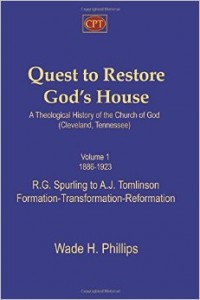Quest to Restore God’s House: A Theological History of the Church of God. Wade H. Phillips. Cleveland, TN: CPT Press, 2015.
 For years Charles W. Conn’s Like a Mighty Army has been the definitive history of the Church of God. Conn’s book offers an excellent telling from the perspective of an officially sanctioned publication. Mickey Crews’ The Church of God: A Social History offers a more critical telling of the early years of the Church of God movement. But neither can compare to the exhaustive volume produced by Wade H. Phillips – Quest to Restore God’s House: A Theological History of the Church of God.
For years Charles W. Conn’s Like a Mighty Army has been the definitive history of the Church of God. Conn’s book offers an excellent telling from the perspective of an officially sanctioned publication. Mickey Crews’ The Church of God: A Social History offers a more critical telling of the early years of the Church of God movement. But neither can compare to the exhaustive volume produced by Wade H. Phillips – Quest to Restore God’s House: A Theological History of the Church of God.
Wade Phillips has made a substantial contribution to the history of the Church of God movement. Quest to Restore God’s House is a well-researched and documented history of the beginnings and early development of the Church of God movement. Phillips presents the personalities and theology that shaped the early decades of one stream of Pentecostalism. This book is not a hagiography. Phillips presents the story clearly, allowing the reader to see the power and glory of early Pentecostalism; along with the corrupt and egotistical men and women whose behavior betrayed the very movement they held dear.
Many readers will be surprised to discover that the Church of God movement was primarily about ecclesiology; not pneumatology. The earliest leaders, R. G. Spurling and A. J. Tomlinson, were reformers and restorationists. Spurling’s passion was to reform the ecclesiology of the Landmark Baptist movement. Tomlinson embraced Spurling’s vison with an uncommon passion and energy and offered his own revisioned ecclesiology. Spurling’s The Lost Link and Tomlinson’s The Last Great Conflict present a restorationist ecclesiology that envisions an eschatological church that perfectly reflects the Apostolic church. Phillips masterfully traces the various streams of influence that informed Spurling and Tomlinson, including American political philosophy, and Holiness and Quaker influences. The Church of God movement later embraced Pentecostalism due to various preachers influenced by the Azusa Street revival.
Phillips writes that the Church of God movement was born with a birth defect. In reading his work, it becomes clear that there were many defects that led to a major disruption and division of the movement. The movement’s aversion to historical Christian creeds, and it’s insistence that the ancient church apostatized during the time of Constantine, led to the acceptance of heretical Trinitarian and Christological heresies – Tritheism and Arianism. Among the movement’s glaring defects was the development of its ecclesiology – which formed a marriage between charismatic empowerment and hierarchical institutionalism that paralleled, even rivaled, Roman Catholicism.
The disruption of the Church of God movement can be primarily understood as a conflict between two powerful men – A. J. Tomlinson and J. S. Llewellyn. As stated earlier, Phillips has not written a hagiography. Although he sees these early Pentecostal pioneers as great visionaries, they have feet of clay. Even though they are passionate about the mission of the Church of God, their carnality and incompetence endangered the very Church to which they had given their lives. Phillips admits that he is prejudiced in favor of Tomlinson. Even though he does not question Tomlinson’s motives, Phillips does not hesitate to be critical of Tomlinson’s egotism and incompetence.
Wade Phillip’s Quest is filled with personal information of early Pentecostal pioneers, photographs, and his footnotes reveal a treasure of historical sources. Scholars of the Church of God movement and early Pentecostalism will find this book to be a valuable resource.
